What are Kedarnath (JyotirLinga) history (information) (facts) | Nara Narayana story
Namaste friends, how are you doing today? Welcome to #BhagavanBhakthi website / blog.
Bhagavan Lord Sri Vishnu and Lord Shiva blessings to you and your family!
In this website / blog, you will always learn about #Hinduism #Sanskrit language.
Also subscribe to my YouTube channel from this link #BhagavanBhakthi to view videos about #Hinduism #Sanskrit language.
Just before moving towards to know about “Kedarnath (JyotirLinga) history (information) (facts) | Nara Narayana story“, let us know few basic information about the beautiful Lord Shiva family.
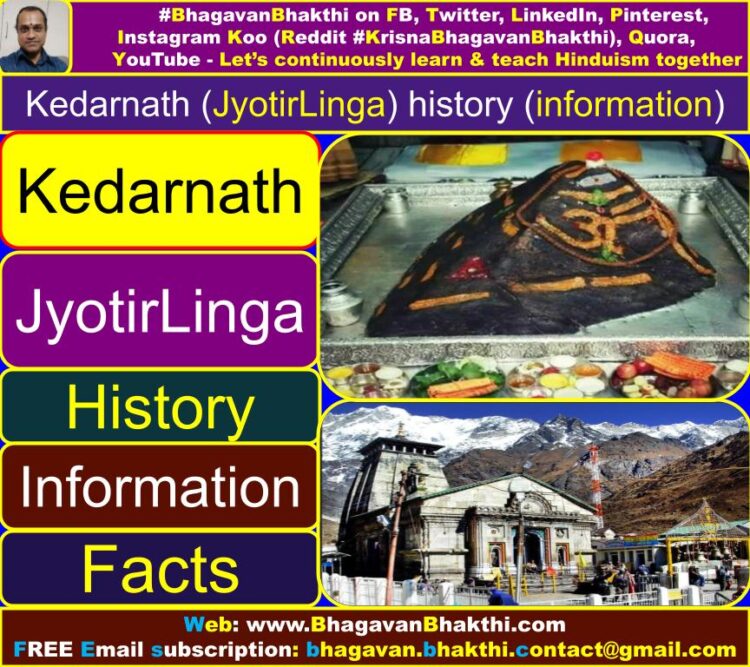
Lord Shiva is the head of this family. His consort name is Goddess Sri Parvati Devi.
They have two sons namely Lord Ganesha and Lord Kartikeya.
Lord Ganesha has divine elephant face, while Lord Kartikeya has 6 heads and thus Lord Kartikeya is known as as ‘Shanmukha‘.
(Here Shanumukha = Shan + Mukha. Here Shan = 6 and Mukha = face. Shanmukha is someone who has 6 head or faces).
Lord Shiva, Goddess Sri Parvati Devi, Lord Ganesha and Lord Kartikeya all stay in a divine place called Kailasha (Kailash).
Along with these four of them, there are multiple other divine people living in Kailasha (Kailash).
Few of the names are Nandi, Bhringi, many Ganas, etc.
Lord Shiva’s mount is Nandi, Goddess Sri Parvati Devi mount is Simha (Divine Lion),
Lord Ganesha mount is Mushaka (Mushak) (Divine Mouse) and Lord Kartikeya mount is Mayura (Mayur) (Divine Peacock).

The fifth of the jyotirlingas is Kedara (Kedar) (Kedarnath) (Kedarnatha) (केदारनाथ) (kēdāranātha).
Etymology of the name (word) Kedarnath is as given below:
The name “Kedarnath” is the present day pronunciation. But in Sanskrit it is called as “Kedaranatha“.
Kedar (Kedara) means in Sanskrit means “paddy field” and nath (natha) in Sanskrit means the “owner or Lord“.
Thus, Kedarnath (Kedaranatha) means, he (Lord Shiva) is someone who is the owner or Lord of the paddy field.
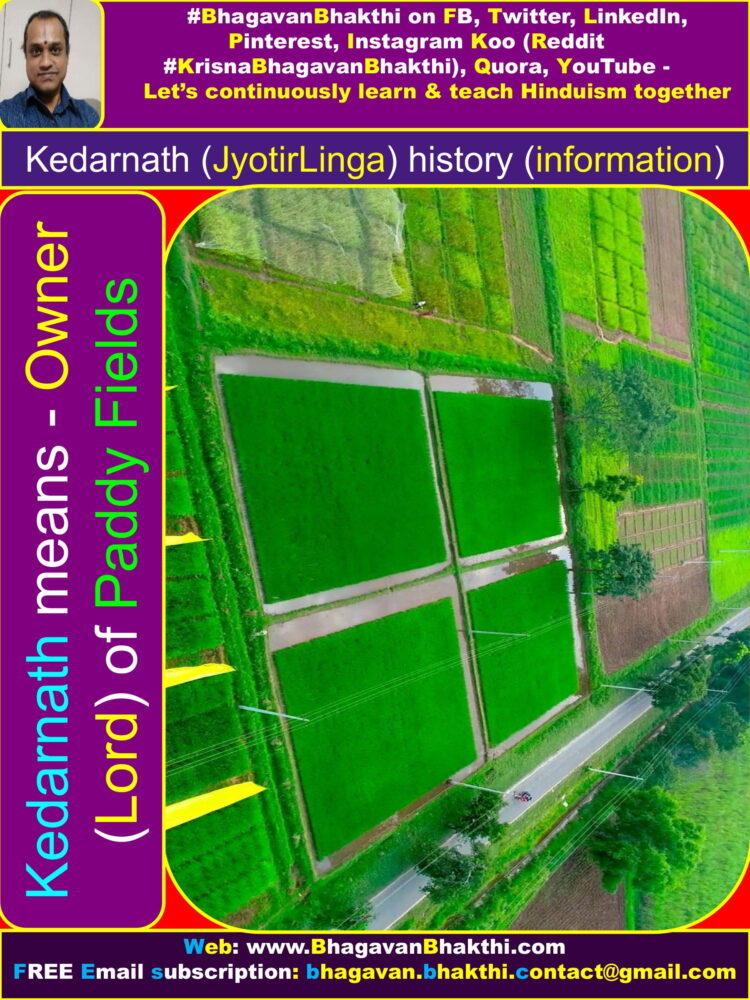
Origin of the name Kedar (Kedara) (Kedarnath) is as given below:
The greatest epic Mahabharata, which states about the Dharma Yudh between Pandavas and Kauravas, does not mention any place called Kedarnath.
Whereas, one of the earliest credentials to Kedarnath is given the Skanda Purana.
Skanda Purana includes a story describing the origin of the Ganges river (Birth of Goddess Sri Ganga Devi).
The Skanda Purana tells about the name Kedara (present Kedarnath), where Lord Shiva released the most holiest water Ganga from his matted hair (Jatadhari – जटाधारी / jaṭādhāri).
(First Ganga takes birth from Lord Sri Vishnu’s foot, then she goes to Lord Sri Brahma Deva’s Kamandala, later she goes and sits on Lord Shiva’s head.)
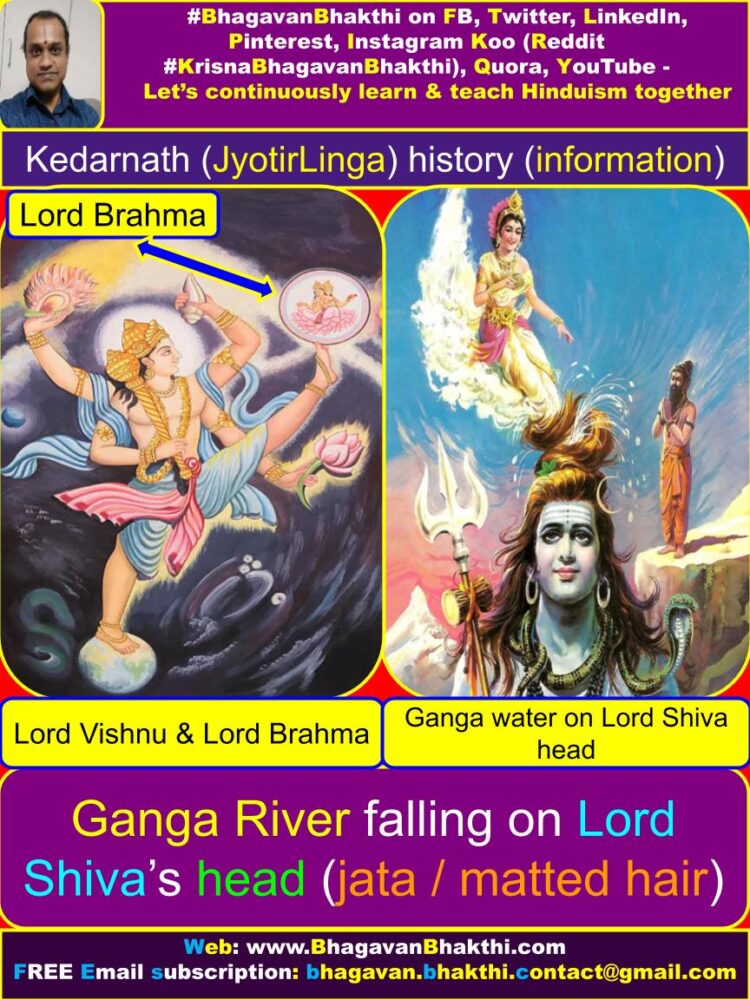
History and legend of Kedarnath temple is as given below:
In Hindu texts says that Lord Shiva manifested in form of Jyotirlinga.
There are Dwadasha JyotirLingas (12 JyotirLingas) in India and Kedarnath is one among them.
The Dwadasha (12) JyotirLingas names are as given below:
Somnath (Somanatha) in Saurashtra, Sri Mallikarjuna (Mallikarjun) in Srisailam, Mahakal (Mahakala) (Mahakaleshwara) (Mahakaleshwar) in Ujjain,
Omkareshwar (Omkareshwara) in Khandwa, Baidyanath (Vaidyanath) in Deoghar, Bhimashankar (Bhimashankara) in Dakinya,
Rameshwaram (Ramesham) (Rameshwara) in Sethubandh, Nagesham (Nageshwara) (Nageshwar) in Daruka-Vana,
Vishwanath (Vishwesham) (Vishweshwara) (Vishweshwar) in Varanasi, Trimbakeshwar (Tryambakam) (Trayambakeshwara) (Trayambakeshwar) at bank of the river Gautami (Godavari),
Kedarnath (Kedaranatha) in the Himalayas and Grishneshwar (Ghushmeshwar) (Ghushmesh) (Ghushmeshwara) in Shivalay (Aurangabad, Maharashtra).

This spectacular and divine temple (present temple) of Kedarnath is highly ancient and constructed over a thousand year ago by Jagad Guru Adi Shankaracharya.
The Kedarnath temple is at the height of 3,583 m and 223 km from Rishikesh.
Kedarnath is on the shores of Mandakini river, a tributary of Ganges River and is a stone edifice of unknown date.
No texts gives the exact origin of Kedarnath temple. As said above in Sanskrit Kedarnath (Kedaranatha) means “the lord of the paddy field“.
The text ‘Kashi Kedara Mahatmya‘ explains that Kedarnath is so called because of “मोक्षस्य सस्यम्” (The crop of liberation) grows here.
A legend about Pancha Kedara (Panch Kedar) links to the great Pancha Pandavas (Five Pandava Heroes) of the Hindu great epic Mahabharata.
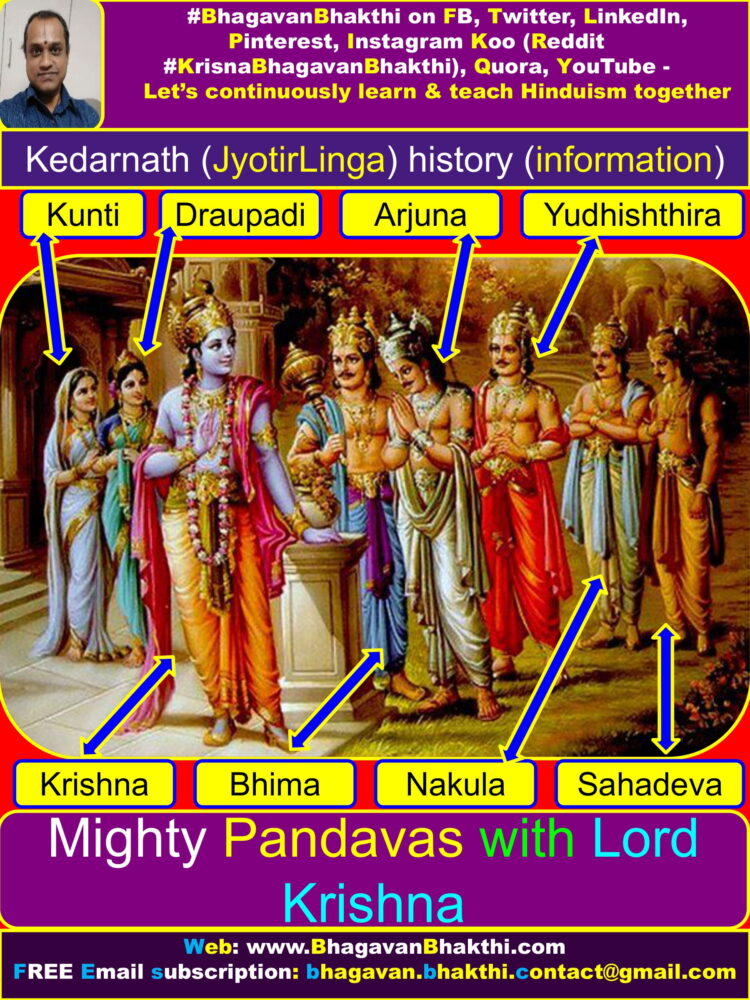
The Pandavas defeated and completely eliminated all the Kauravas cousin brothers in the Mahabharata (Kurukshetra) war.
All the five Pandavas wanted to expiate for the killing their cousin brother, that is –
Since five Pandavas had eliminated all the 100 Kaurava brothers who belonged to their own gotra (fratricide) (gotra hatya) and also they had killed few Brahmanas (Brāhmanahatya) in the war.
For this reason, the Pandava brothers handed over the reins of their kingdom to Parikshit Maharaj (Grandson of Arjuna and son of Abhimanyu) and left in search of Lord Shiva to seek his blessings.
Firstly, the Pandava brothers went to the holy city of Varanasi (Also called as Kashi or Benaras) and prayed to Lord Vishwanath (Shiva) over there.
But here, Lord Shiva assumed the form of a bull (Nandi) and hid in the Garhwal region.
Not finding Lord Shiva in Varanasi (Also called as Kashi or Benaras), the five Pandavas went to Garhwal Himalayas.

The great and mighty Bhima, the most powerful among the Pandava brothers, stood near the mountains and started to look for Lord Shiva.
The mighty Bhima saw a bull grazing near Guptakashi (गुप्तकाशी / guptakāśi) or literally means “hidden Kashi”.
(This name Guptakashi is used as Lord Shiva was hiding away from the Pandavas.)
The most powerful Bhima immediately noticed the bull to be Lord Shiva.
The muscular Bhima caught hold of the bull by its tail and hind legs.
But whereas, the bull-form of Lord Shiva (Panch Kedar) disappeared from there and reappeared in parts as given below:
Panch Kedar names is as given below:
a. With the hump raising in Kedarnath.
b. The arms popping up in Tungnath.
c. The face showing up at Rudranath.
d. The navel and stomach emerged in Madhyamaheshwar.
e. And finally the hair appearing in Kalpeshwar.
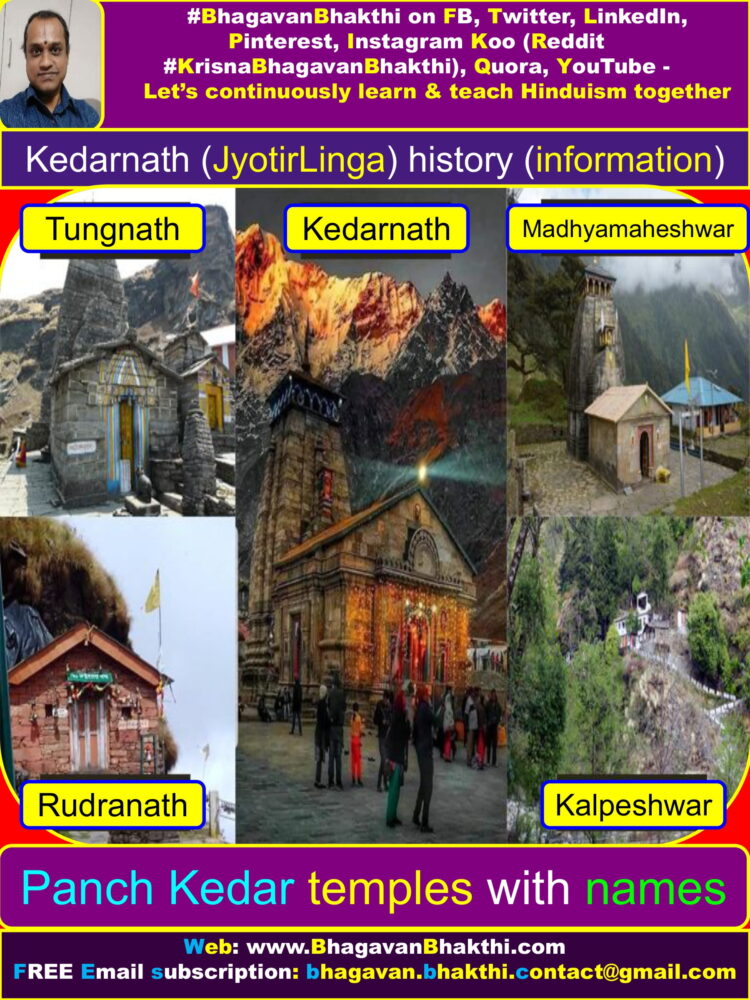
Thus all the five Pandavas were pleased with this reappearance of Lord Shiva in five different forms.
Pandavas built five temples at these five places for venerating and worshipping Lord Shiva.
The five Pandavas, after building the ‘Panch Kedar Temples‘, did the penance at Kedarnath for moksha (salvation).
Pandavas also performed a yajna and did the Mahapanth (Path of going to Svarga Loka) to attain heaven or higher planets.
After getting the darshan of Lord Shiva at the Panch Kedar Temples, it is a regular Dharmic rite to visit Lord Vishnu at the Badrinath Temple.
The great and ultimate epic Mahabharata, which explains completely about the Pandavas and the Kurukshetra battle, where it does not give any details of a place called Kedarnath.
Whereas in Skanda Purana there is a mention of the name Kedara (Present Kedarnath).
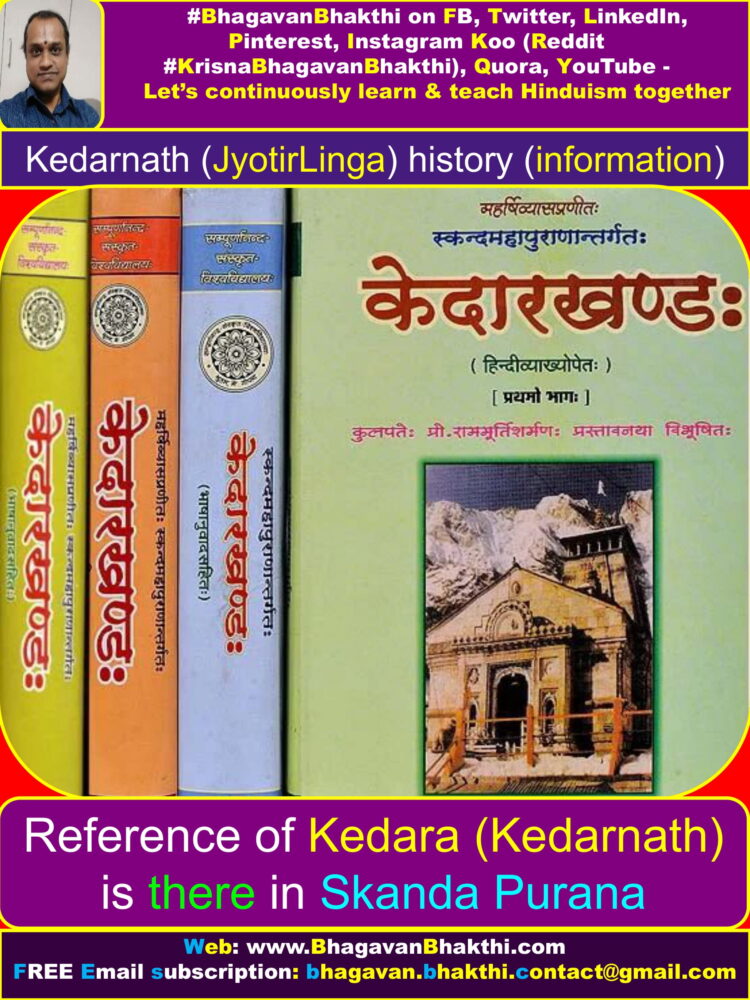
Skanda Purana also states that Kedarnath is the same place where Lord Shiva released the most holiest water from his jata (जटा / jaṭā) (matted hair).
The divine Kedarnath was a prominent pilgrimage site during the 12th century A.D., which is mentioned in Kritya-kalpataru, written by the Gahadavala minister Bhatta Lakshmidhara.
Kedarnath Tirtha Priests are the ancient Brahmins of this region.
These ancestors (Rishis-Munis) have been worshiping the Lord Shiva’s Linga since Nara-Narayana and Daksh Prajapati (Below you find the story of Nara-Narayana).
The great-grandson of the Pandavas (Arjuna), that is, King Janamejaya gave the priests the right to worship at this temple and donated the whole Kedar region to them.
(King Janamejaya is the great-grandson of Arjuna, Grandson of Abhimanyu and son of King Pariksht.)
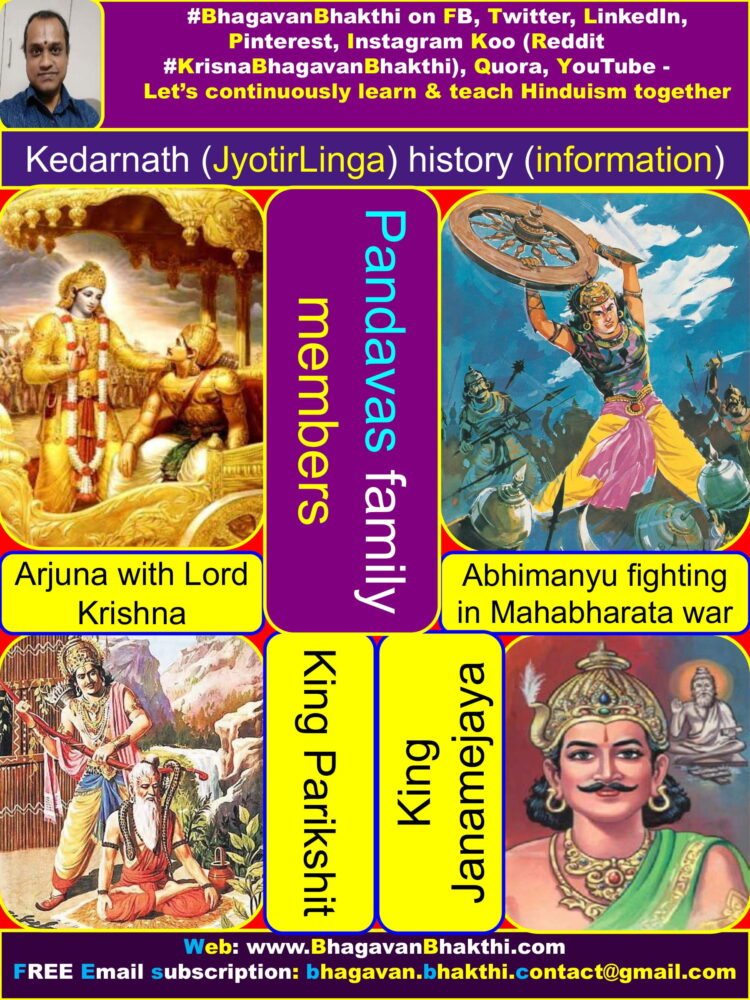
Information about the Kedarnath temple is as given below:
The presiding deity at Kedarnath is in the form of Linga and is not in the normal Linga shape, but is in the irregular shape.
The Kedarnath Linga’s pedestal is 3.6 m (12 ft.) in circumference and 3.6 m (12 ft.) in height.
In front of the Kedarnath temple, a small pillared hall has images of Goddess Sri Parvati Devi and the mighty five Pandava princes that is –
Yudhishthira, Bhima, Arjuna, Nakula and Sahadeva.
Around Kedarnath itself, there are four temples and there names are as given below:
Tungnath, Rudranath, Madhyamaheshwar, and Kalpeshwar.
All these four temples form the Panch Kedar pilgrimage sites including the Kedarnath temple, that is, –
Kedarnath, Tungnath, Rudranath, Madhyamaheshwar and Kalpeshwar.
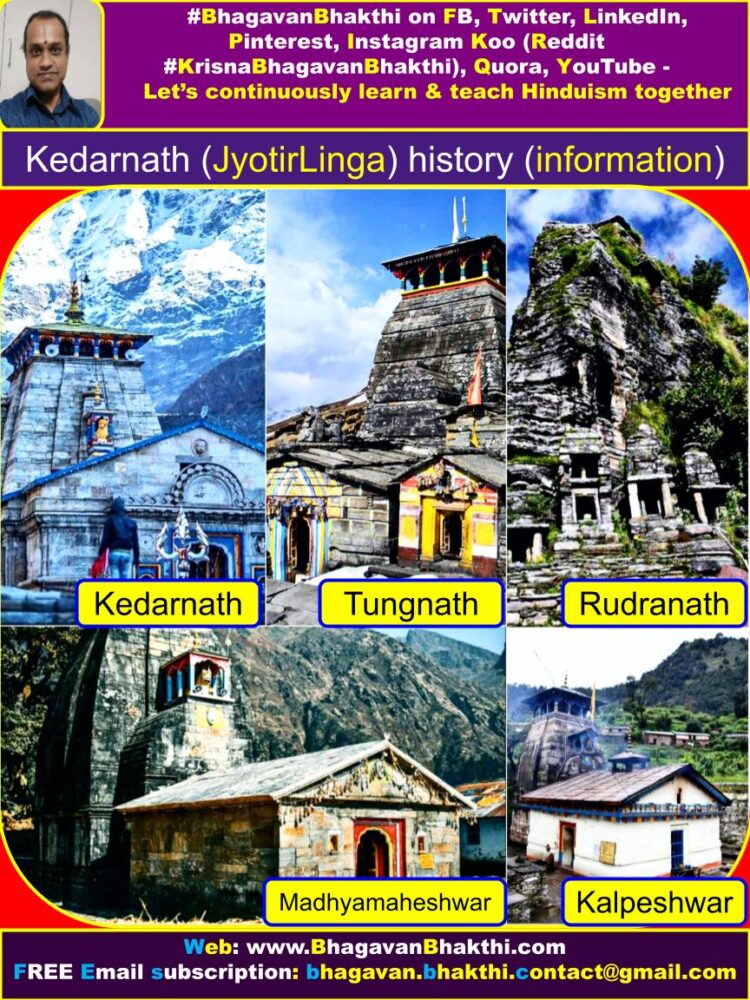
Deities at Kedarnath temple: The first hall inside Kedarnath Temple has the deities of the Lord Sri Krishna, Yudhishthira, Bhima, Arjuna, Nakula & Sahadeva, Nandi (Mount of Lord Shiva) and Virabhadra, one of the guards of Lord Shiva.
Similarly, deities of Sri Draupadi Devi and others are also installed in the main hall.
An uncommon feature of the Kedarnath temple is a man’s head carved on a triangular stone Linga.
Also, a head is carved into another nearby temple built on the site where the vivah (marriage) of Lord Shiva and Goddess Sri Parvati Devi was held.
The principle priest (Raval) of the Kedarnath temple belongs to the Veerashaiva community from Karnataka.
The Raval (principle priest) of Kedarnath temple does not perform the pujas.
Raval’s assistants carry out the pujas as per Raval’s instructions.
The Raval (principle priest) moves with the deity to Ukhimath during the winter season.
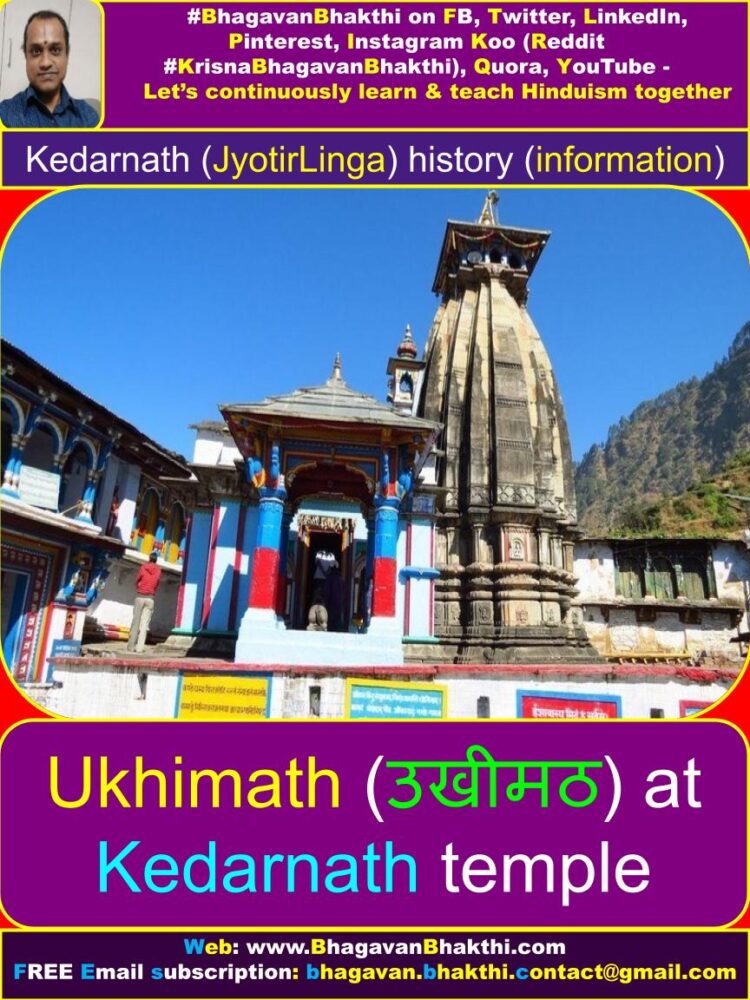
There are five leading priests for the temple at Kedarnath and they become principle priests on rotation basis.
The present Raval (2013) of Kedarnath temple is from Karnataka state, Davanagere district called as Sri Vagisha Lingacharya.
All around the Kedarnath, there are many deities and symbols of the great five Pandavas.
King Pandu (father of five Pandavas) died at Pandukeshwar. The local tribal people here perform a dance called “Pandav Lila” (Pandava Leela).
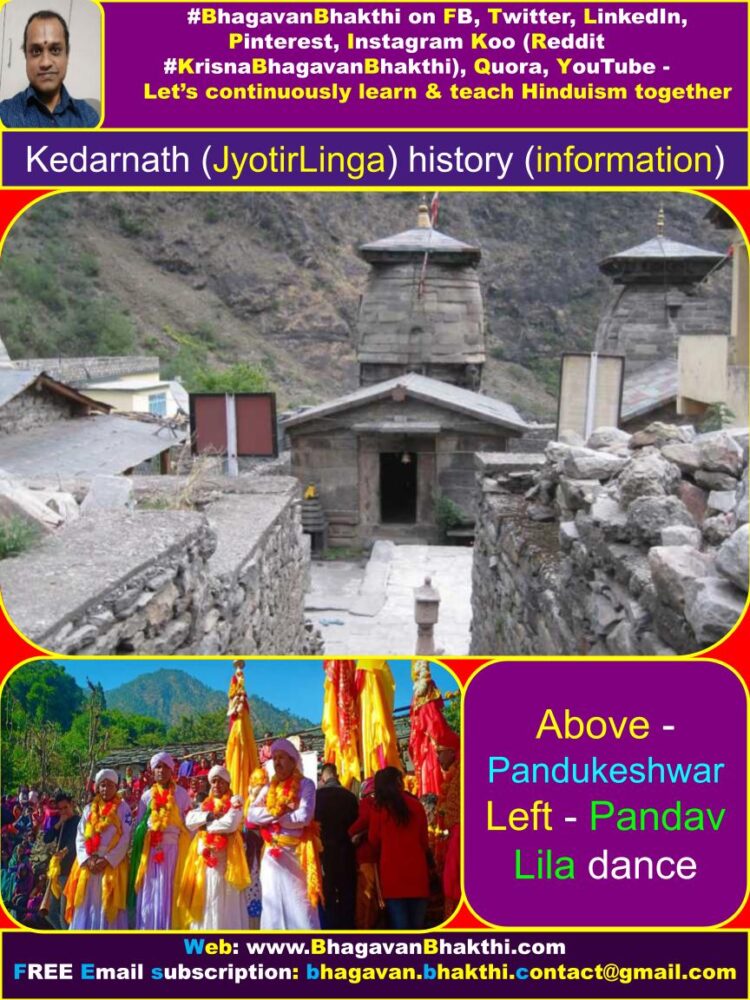
The mountain top where the Pandavas went to Svarga Loka is known as “Svargarohini” (Svarga Rohini – Climbing the steps of Svarga) and this is located off Badrinath.
When the eldest of the Pandavas Yudhishthira was on the way to Svarga Loka, one of his fingers fell on the earth.
At that place, Yudhishthira installed a Shiva Linga, the size of a thumb.
Nara Narayana story is as given below:
In one of Lord Sri Vishnu’s avatar, he revealed himself as Lord Narayana and Lord Sri Adishesha Deva (The Serpent God – Bed of Lord Vishnu) as Nara.
(The great and divine fame of Nara Narayana.)
These two sages prayed for a long time in the hermitage (Ashram) known as Badrinath (Badrinatha) (Badrikashrama) (Badrikashram).

Near this hermitage (ashram) there was a peak of the Himalayas named Kedara (Kedar).
After the two sages had prayed to Lord Shiva for a very long time, Lord Shiva appeared and said like this: “I don’t understand why the two of you worshipping me”.
“It is you who should be worshipped. But since you have been praying to me, let me grant you a boon.”
Nara and Narayana desired that Lord Shiva should always be present in the form of a Linga on the peak Kedara (Kedar).
Once Lord Shiva’s son Lord Kartikeya asked Lord Shiva:
“How did this Badarikashram (Badrikashrama) (Badrinath) (Badrinatha) (a place called Badari + ashram) sacrosanct place originate? Who is the presiding deity of this place?”

(Few people pronounce this divine name as Badrikashram or Badrinath, which is partially incorrect.)
(The correct way of pronunciation this divine name is Badarikashrama or Badrinatha.)
(This is a Sanskrit name) – बदरिकाश्रम / ಬದರಿಕಾಶ್ರಮ / badarikāśrama / बदरीनाथ (बद्रीनाथ) / ಬದರೀನಾಥ / badarīnātha).
Lord Shiva replied: ‘Badrikashram (Badrikashrama) (Badrinath) (Badrinatha) is an eternal city and Lord Sri Narayana is its presiding deity.’
‘A mere sight of Badrikashram (Badrikashrama) (Badrinath) (Badrinatha) is enough to free a man from all the bondage of life.’
‘There are numerous other holy places situated in the vicinity, Kedaranatha (Kedarnath) being one of them.’
To emphasize the significance of Badrikashram (Badrikashrama) (Badrinath) (Badrinatha), Lord Shiva narrated the following tale to Lord Kartikeya:
‘In Satya Yuga, Lord Sri Vishnu existed in his physical form at Badrikashram (Badrikashrama) (Badrinath) (Badrinatha) for the benediction of human beings.’
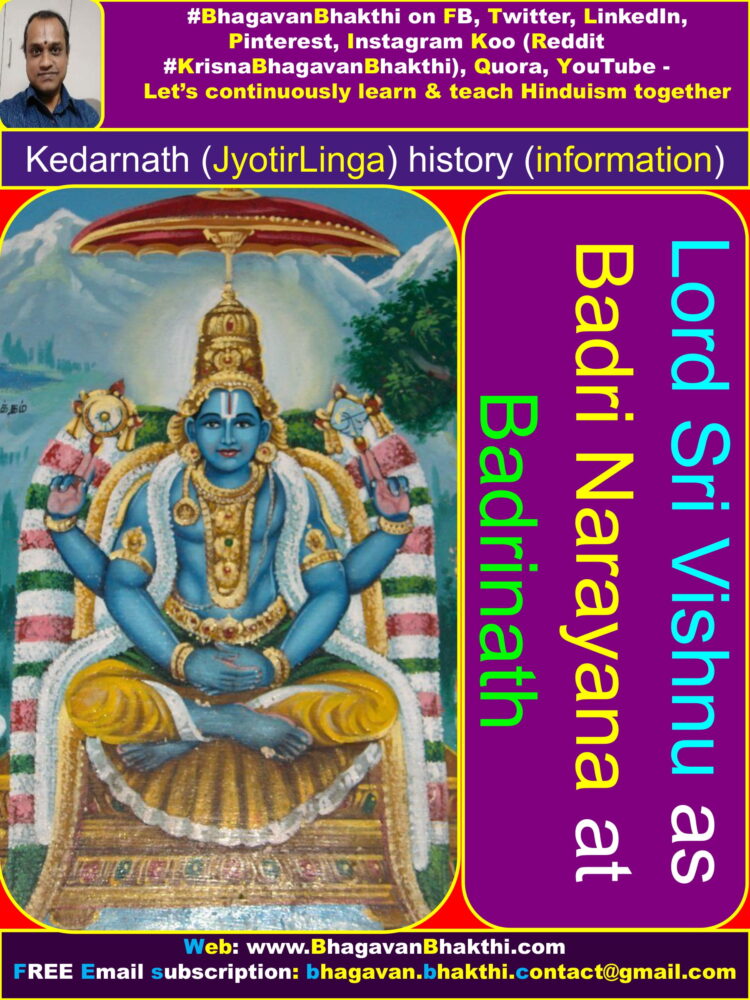
‘But, in Treta Yuga, only Rishis / sages had the privilege of perceiving Lord Sri Vishnu with the help of yoga.’
‘At the advent of Dwapara Yuga, things changed drastically and Lord Sri Vishnu just disappeared from Badrikashram (Badrikashrama) (Badrinath) (Badrinatha).’
‘Deities became worried and asked Lord Sri Brahma Deva about the reason that made Lord Sri Vishnu disappear.’
‘Even Lord Sri Brahma Deva had no answer to this question.’
‘Thinking that Lord Sri Vishnu must have gone to Ksheera (Kshira) sagara (Vaikunatha), that is –
Lord Sri Vishnu’s eternal abode, all the deities led by Lord Sri Brahma Deva went to Ksheera (Kshira) Sagara (Divine Milky Ocean) (Vaikuntha).’
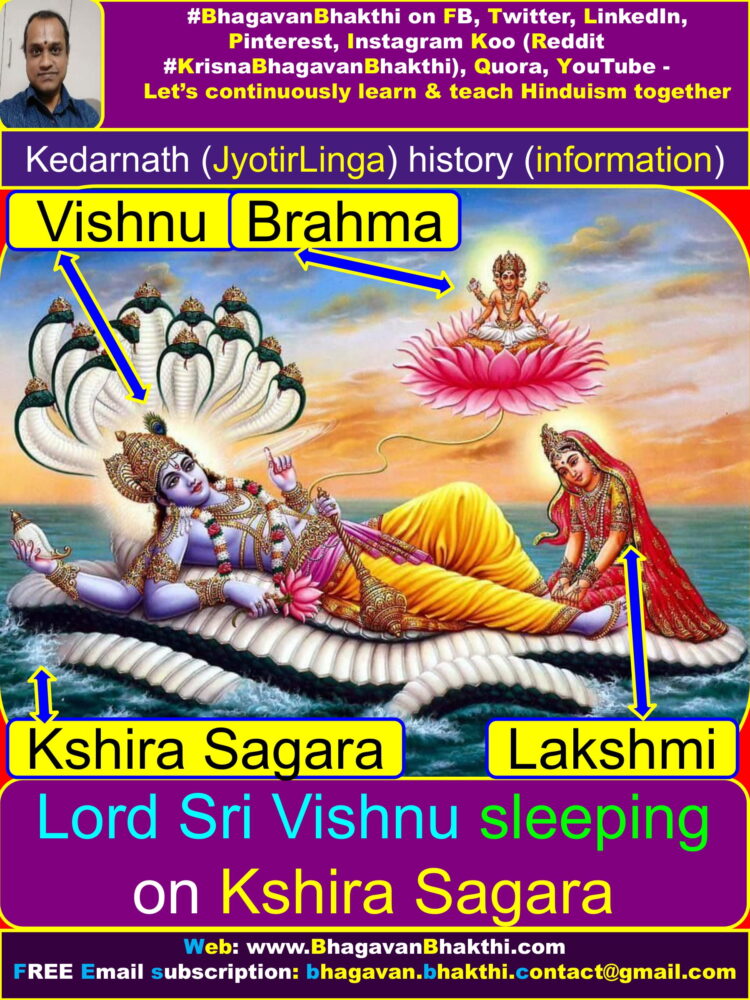
‘All the deities eulogized Lord Sri Vishnu, who emerged from the Ksheera (Kshira) sagara.’
‘But, none of the deities except Lord Sri Brahma Deva could see the Supreme Lord Sri Vishnu.’
‘Lord Sri Vishnu told Lord Sri Brahma Deva that the main reason why he disappeared from Badrikashram (Badrikashrama) (Badrinath) (Badrinatha) was the flawed intelligence and arrogance of the deities.’
‘Lord Sri Brahma Deva informed the deities whatever Lord Sri Vishnu had told him.’
‘All the deities were ashamed of themselves and returned to heaven with long faces.’
‘Feeling pity on the deities, I (Lord Shiva) disguised myself as a Sanyasi (Saint) and carried Lord Sri Vishnu’s deity from Narada Tirtha to Badrikashram (Badrikashrama) (Badrinath) (Badrinatha)‘.

‘And installed it over there to uplift the sagging morale of the deities.’
‘This is how Lord Sri Vishnu once again graced Badrikashram (Badrikashrama) (Badrinath) (Badrinatha) with his presence.’
‘Even a grain of ‘prasada (prasad)’ had at Badrikashram (Badrikashrama) (Badrinath) (Badrinatha) is enough to liberate a man from all his sins.’
This is the very place where even today Lord Sri Vishnu in his Sri Nara Narayana avatar still exists physically.
Lord Sri Vishnu in his Sri Nara Narayana fame, that is –
Here Lord Sri Narayana means svayam Lord Sri Vishnu and Sri Nara means the Lord Sri Adishesha Naga (the same serpent on which Lord Sri Vishnu sleeps) still has the abode.
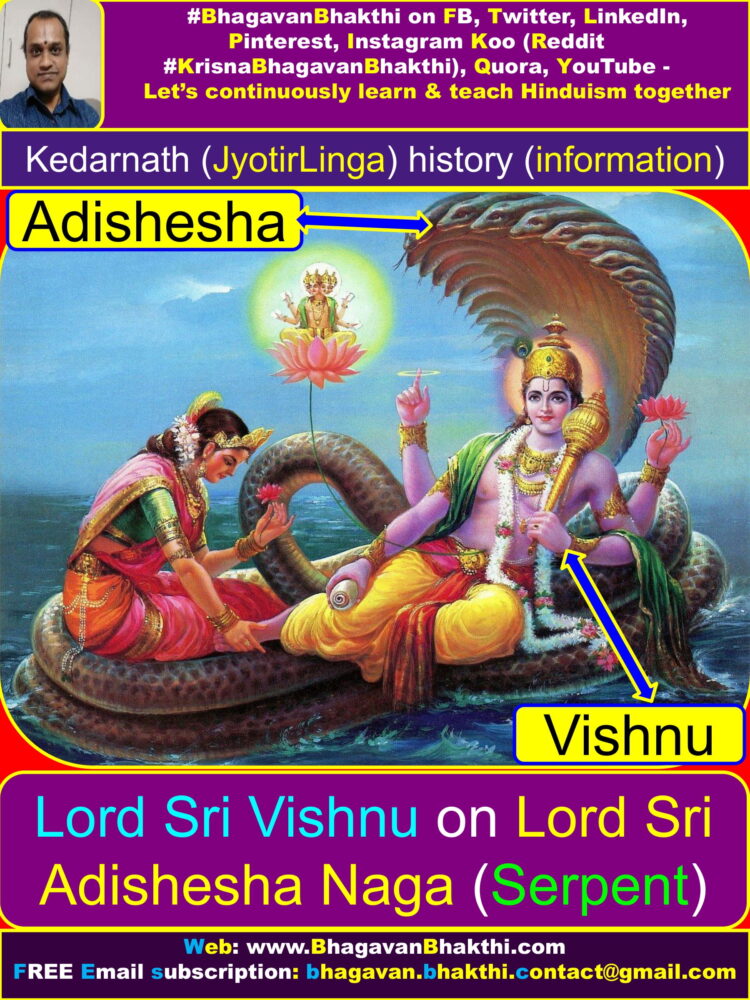
Lord Sri Adishesha Naga would never want to leave Lord Sri Vishnu alone.
Even in the Treya Yuga, Lord Sri Adishesha Naga in his Sri Lakshmana avatar had taken birth along with Lord Sri Rama Chandra Prabhu to do seva (serve) of Lord Sri Rama.
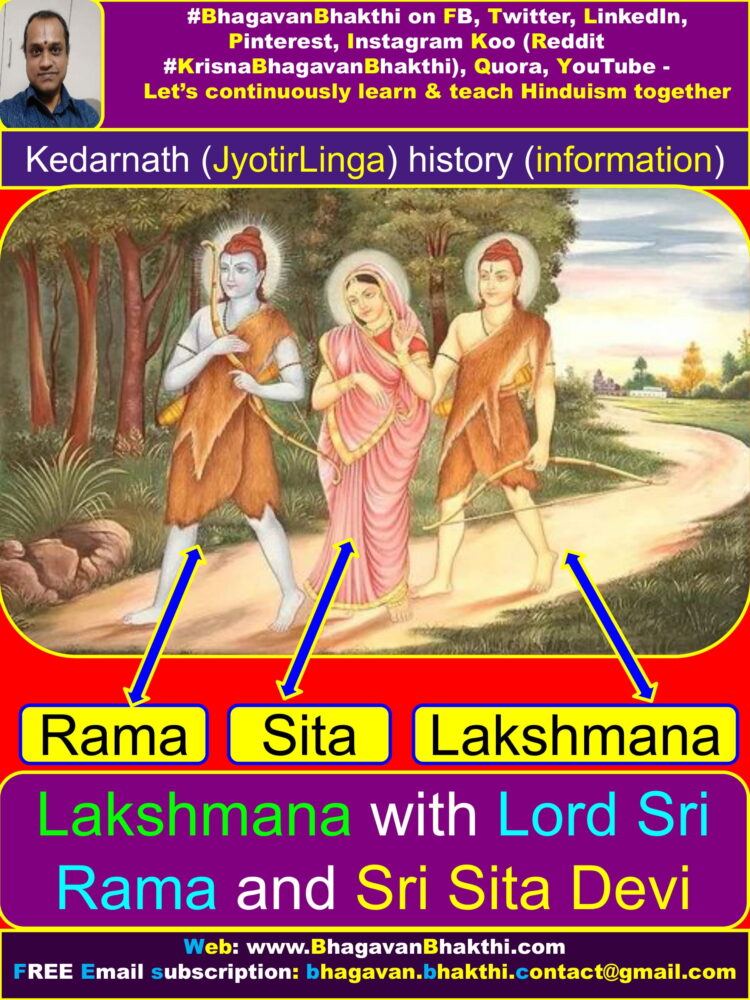
In the Treta Yuga, Lord Sri Adishesha Naga in his Sri Balarama avatar had taken birth along with Lord Sri Krishna Paramatma to do seva (serve) of Lord Sri Krishna.

Similarly in the Kali Yuga, Sri Adishesha Naga has taken the Sri Nara avatar to do the seva (serve) of Lord Sri Narayana (Vishnu).
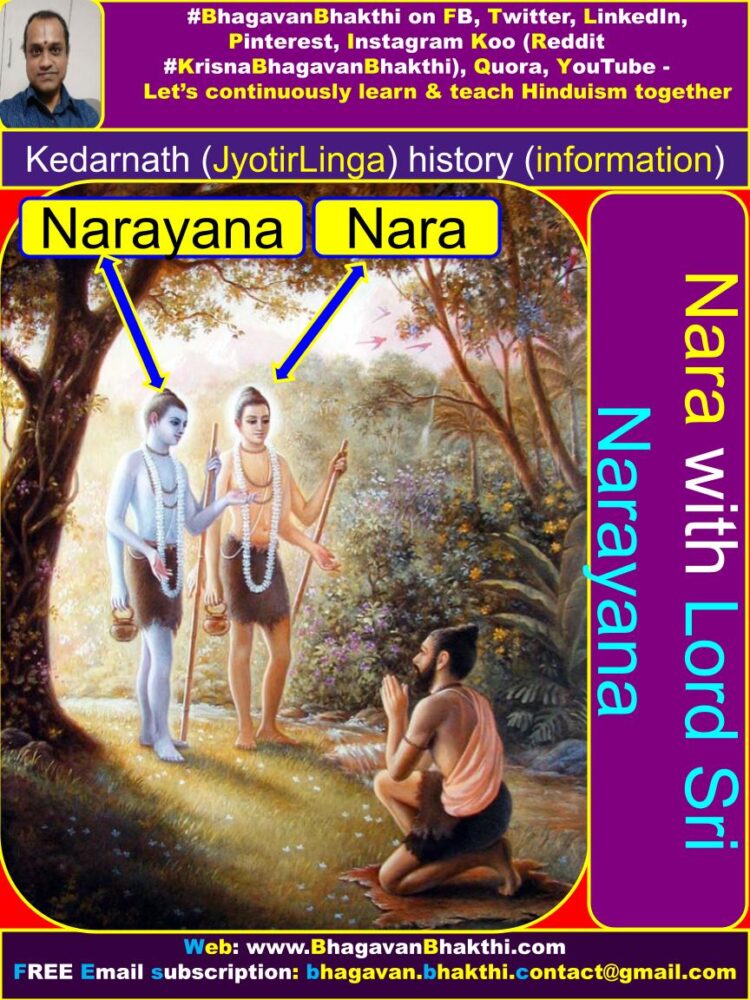
Also in the same place svayam Lord Sri Vishnu in his another avatar, that is Lord (Sage) Sri Veda Vyasa Ji (he is also an avatar of Lord Sri Vishnu) still lives in the same place physically.
This avatar of Lord (Sage) Sri Veda Vyasa Ji is same avatar as during the Mahabharata period.
Just around 800 years back when the great Saint Sri Madhvacharya Ji went to Sri Badrikashram (Badrikashrama) (Badrinath) (Badrinatha) –
Sri Madhvacharya Ji met both the Lord Sri Vishnu avatars, that is –
Sri Madhavacharya Ji met both Lord Sri Narayana (Badri Narayana) (Vishnu) and also Lord (Sage) Sri Veda Vyasa Ji.
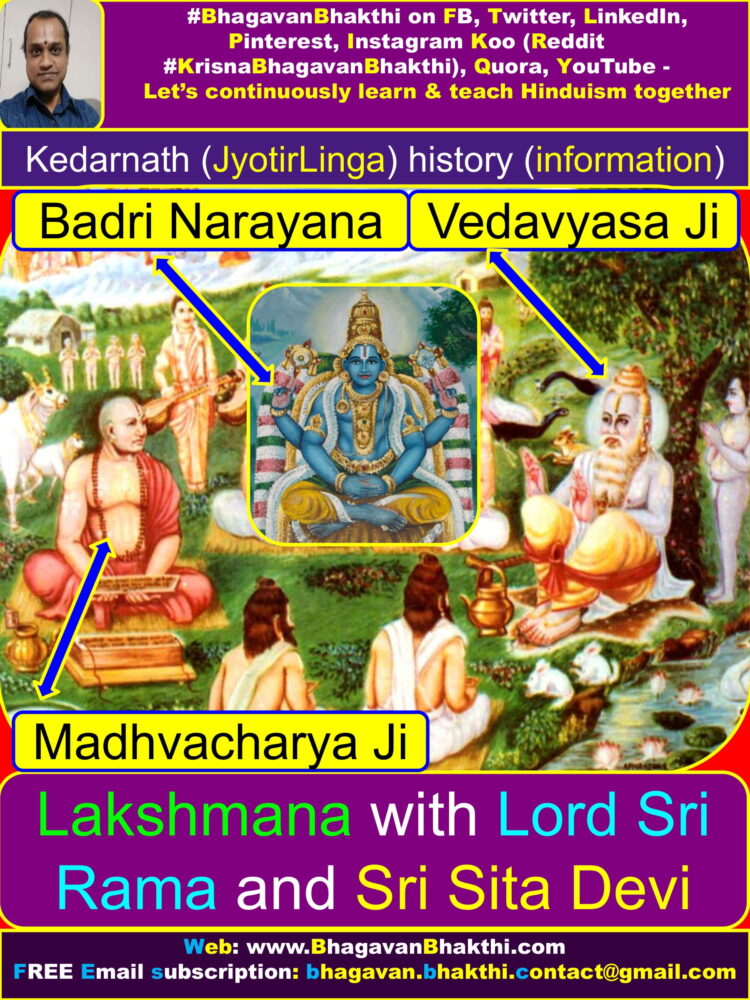
This is the greatness of our great Bharata bhoomi (India).
Svayam Lord Sri Vishnu and other Devatas (Demigods) will take avatar to uplift the common people (devotees).
This will go on and on and on…
Sanatana Dharma was the Adi Dharma (Dharma which is present since the unknown time time), is the Greatest Dharma and will be the Greatest Dharma forever.
Sanatana Dharma is called as ‘Dharma‘, as it was started by svayam Lord Sri Vishnu.
Whereas all the other religions which existed earlier or which is existing today and which will exist in the future are created by mere humans.
Also we should note that Sanatana Dharma doesn’t has any end to it.
Sanatana Dharma is like a cycle, it keeps on repeating and repeating and repeating…
After every Maha Kalpa, a new and fresh Maha Kalpa starts and this will go on and on and on…
In each Maha Kalpa Lord Sri Brahma Deva, Goddess Sri Sarasvati Devi, Lord Sri Rudra Deva (Shiva), Goddess Sri Parvati Devi and Devatas (Demigods) changes.
Everybody and everything changes except Lord Sri Vishnu and Goddess Sri Mahalakshmi Devi.

Lord Sri Vishnu is the Adi Deva (Present since unknown time frame), he was present when nothing was there, he is present even today and also he will be present ever after.
Goddess Sri Mahalakshmi Devi is the greatest devotee of Lord Sri Vishnu and thus, She also stays along with Lord Sri Vishnu for ever.
Goddess Sri Mahalakshmi Devi can’t go away from Lord Sri Vishnu, as she is the most dearest Devi (Divine Goddess) of Lord Sri Vishnu.
For this reason Lord Sri Vishnu has kept Goddess Sri Mahalakshmi Devi in his Vaksha Sthala (I am not sure of the English word for Vaksha Sthala, nearest words are at the chest side).
Because of our Punya Karma (Good deeds), we have taken birth in this GREAT BHARATA Bhoomi (India).
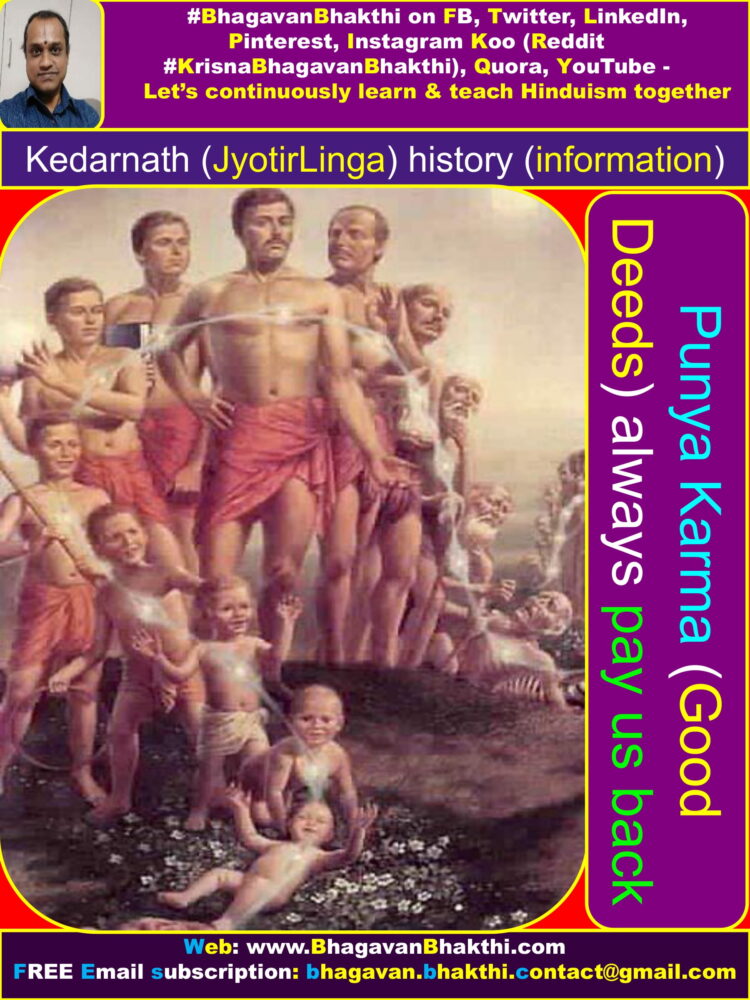
We are not sure in the next life, where we would take birth. Whether we will take birth as humans or other beings
If we don’t make use of the present life, then we may have to pay in this life itself and / or in the next life or lives.
Bharata bhoomi (India) is called as the Karma Bhoomi, as the Karmas done on this Bhoomi (India) is counted.
It is left to us to believe the GREAT SANATANA DHARMA which was started by svayam Lord Sri Vishnu or to follow the mere religions which are started by the mere people to get fame, power, greed, etc.
This is left to you…

Information about how to reach Kedarnath temple is as given below:
Kedarnath (Kedarnath temple) is located in the state of Uttarakhand.
It can be reached by air, train, road since it has been connected with railway stations and airports.
BY AIR : The nearest domestic airport is Jolly Grant Airport in Dehradun, about 239 km from Kedarnath.
Jolly Grant Airport in Dehradun operates daily flights to Delhi.
Taxis are available from Dehradun airport to Kedarnath. Nearest international airport is Delhi (Indira Gandhi International Airport).
BY TRAIN : The nearest railhead is at Rishikesh, 221 km away. Pre-paid taxi services are available at the railway station which charge about Rs. 3,000.
One has to travel 207 km by road and the rest 14 km on foot to reach Kedarnath.
BY ROAD : Pilgrims (visitors) can board regular buses from Rishikesh and Kotdwar to Kedarnath. Private cabs can also be hired from these places.
The National Highway from Delhi to Mana (538 km) remains open throughout the year.
Kedarnath is also accessible by foot from GauriKund, which is connected by state buses to Rishikesh, Dehradun, Kotdwara and Haridwar.
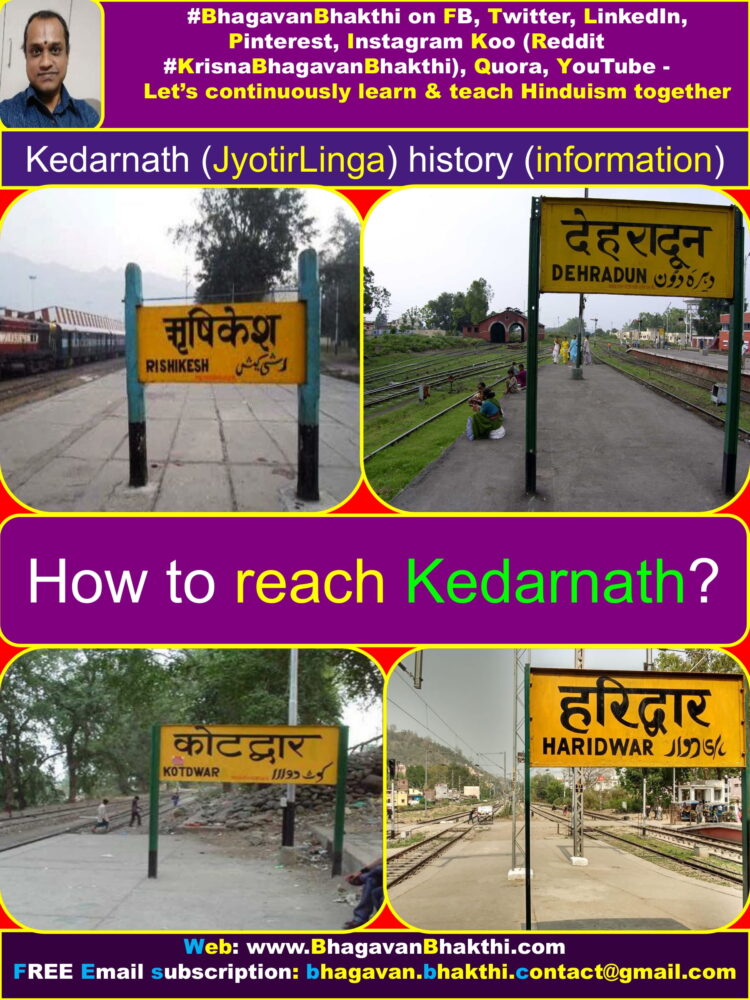
More information will be added to this on regular, please visit after some time to know more information.
To watch videos on #Hinduism #Sanskrit language, SUBSCRIBE to my YouTube channel from this below link:
#BhagavanBhakthi YouTube channel
To know more about “Lord Shiva unknown facts“, please click the below link:
To know more about “Maha Prayala, Great Tribulation or Qayamat as per Hindu Sanatana Dharma“, you can visit this below link:
Maha Pralay or Great Tribulation or Qayamat meaning according to Hinduism
Dear friends, if you need any clarifications about this post, kindly let me know, I will definitely try to answer all of them.
Also your one LIKE, one COMMENT, One Share, one SUBSCRIPTION is highly important.
This will help to know the quality of this content and also it will be helpful to know if any improvements is required for the content.
If you feel this content is useful to you and has helped you to improve your knowledge, kindly share this with your well-wishers.
Because “SHARING MEANS CARING”.
For receive FREE EMAIL SUBSCRIPTION about #BhagavanBhakthi, you can send an email to bhagavan.bhakthi.contact@gmail.com from your email ID.
NAMASTE!
OM NAMO NARAYANAYA
Sri Krishnaaya Namaha
Sri Krishnaarpanamastu
Would love to forever get updated great web blog! .